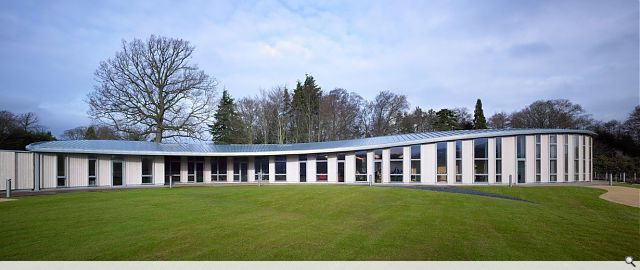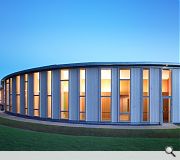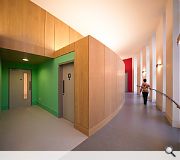Centre for Scottish War Blinded
Scottish War Blinded was founded in Edinburgh in 1915 with the object of caring for Scotland’s sailors, soldiers and airmen and women who were blinded in the service of their country. With the organisation now taking in a higher number of veterans of more recent conflicts, the Scottish War Blinded recognised that a new facility was required so that the scope and quality of the services they offer could be improved.
Their new 750m2 facility is located on an inspiring site at Linburn, West Lothian and replaces the charity’s 1950’s facility which occupied an adjacent site. The scheme takes inspiration from a hand-carved Chinese celestial dragon memorial sculpture which was housed in the display room of the previous facility. This inspiration manifests itself in the sweeping and twisting geometry of the building’s undulating zinc roof.
The building operates as a day care centre and offers a comfortable and sociable environment whilst also providing rehabilitation and life skills assistance for ex-servicemen and women suffering from visual impairments. Facilities include a workshop, art space, training areas, a gym, therapy spaces and administration as well as a remembrance room. A terrace and landscaped sensory garden to the south of the building is also provided for recreational use in addition to education. The shifting demographic of users that the organisation now supports has influenced this broad mixture of activities.
The building harbours a strong focus on internal flow, with a mainly open plan arrangement fed by one, generous circulation spine. The accommodation is organised so that the circulation and larger spaces are placed near the external walls, while smaller, ancillary spaces requiring enclosure, privacy and acoustic insulation are placed in ‘pod’ elements nearer the centre of the plan. The organisation of the building aims to be as simple as possible so that the users can easily form a mental picture of the building, thus allowing straightforward navigation. In addition, bold gestures (both architecturally and through the use of colour) are made at doorways and changes of direction to further assist building users’ wayfinding.
The curving geometry has been formed by the use of steel portal frames set out on a radial grid and in-filled with cold rolled purlins. The twists and sweeps of the geometry have been formed by gentle facets, with the steel frame only including two relatively short curved structural members. A restrained palette of materials are used throughout the building to clad the steel structure beneath. The roof is formed in zinc strips with the external walls clad in timber panels set out alongside large glazed openings. Internally, the ‘pod’ type spaces are picked out in oak and detailed to sit like pieces of furniture under the large twisting roof.
From the onset the design of the new centre for the Scottish War Blinded was based on sustainable principles. Natural ventilation is utilised in the majority of the spaces and heating is supplied from a ground source heat pump. In order to minimise energy requirements, high levels of insulation and air tightness have been designed in to the building envelope. In addition, carefully controlled amounts of glazing have been provided, balancing the need for pulling light deep in to the plan with the need to control glare and solar gain / heat loss.
Photography: Andrew Lee
Their new 750m2 facility is located on an inspiring site at Linburn, West Lothian and replaces the charity’s 1950’s facility which occupied an adjacent site. The scheme takes inspiration from a hand-carved Chinese celestial dragon memorial sculpture which was housed in the display room of the previous facility. This inspiration manifests itself in the sweeping and twisting geometry of the building’s undulating zinc roof.
The building operates as a day care centre and offers a comfortable and sociable environment whilst also providing rehabilitation and life skills assistance for ex-servicemen and women suffering from visual impairments. Facilities include a workshop, art space, training areas, a gym, therapy spaces and administration as well as a remembrance room. A terrace and landscaped sensory garden to the south of the building is also provided for recreational use in addition to education. The shifting demographic of users that the organisation now supports has influenced this broad mixture of activities.
The building harbours a strong focus on internal flow, with a mainly open plan arrangement fed by one, generous circulation spine. The accommodation is organised so that the circulation and larger spaces are placed near the external walls, while smaller, ancillary spaces requiring enclosure, privacy and acoustic insulation are placed in ‘pod’ elements nearer the centre of the plan. The organisation of the building aims to be as simple as possible so that the users can easily form a mental picture of the building, thus allowing straightforward navigation. In addition, bold gestures (both architecturally and through the use of colour) are made at doorways and changes of direction to further assist building users’ wayfinding.
The curving geometry has been formed by the use of steel portal frames set out on a radial grid and in-filled with cold rolled purlins. The twists and sweeps of the geometry have been formed by gentle facets, with the steel frame only including two relatively short curved structural members. A restrained palette of materials are used throughout the building to clad the steel structure beneath. The roof is formed in zinc strips with the external walls clad in timber panels set out alongside large glazed openings. Internally, the ‘pod’ type spaces are picked out in oak and detailed to sit like pieces of furniture under the large twisting roof.
From the onset the design of the new centre for the Scottish War Blinded was based on sustainable principles. Natural ventilation is utilised in the majority of the spaces and heating is supplied from a ground source heat pump. In order to minimise energy requirements, high levels of insulation and air tightness have been designed in to the building envelope. In addition, carefully controlled amounts of glazing have been provided, balancing the need for pulling light deep in to the plan with the need to control glare and solar gain / heat loss.
Photography: Andrew Lee
PROJECT:
Centre for Scottish War Blinded
LOCATION:
Wilkieston, Kirknewton
CLIENT:
Scottish War Blinded
ARCHITECT:
Page\Park
STRUCTURAL ENGINEER:
SKM Anthony Hunt
SERVICES ENGINEER:
Harley Haddow
QUANTITY SURVEYOR:
NDM
LANDSCAPE ARCHITECT:
Ian White Associates
Suppliers:
Main Contractor:
Brown Construction
Back to Health
Browse by Category
Building Archive
- Buildings Archive 2024
- Buildings Archive 2023
- Buildings Archive 2022
- Buildings Archive 2021
- Buildings Archive 2020
- Buildings Archive 2019
- Buildings Archive 2018
- Buildings Archive 2017
- Buildings Archive 2016
- Buildings Archive 2015
- Buildings Archive 2014
- Buildings Archive 2013
- Buildings Archive 2012
- Buildings Archive 2011
- Buildings Archive 2010
- Buildings Archive 2009
- Buildings Archive 2008
- Buildings Archive 2007
- Buildings Archive 2006
Submit
Search
Features & Reports
For more information from the industry visit our Features & Reports section.





